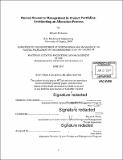| dc.contributor.advisor | Bryan R. Moser. | en_US |
| dc.contributor.author | Botros, Mina N. M | en_US |
| dc.contributor.other | System Design and Management Program. | en_US |
| dc.date.accessioned | 2018-02-08T16:27:05Z | |
| dc.date.available | 2018-02-08T16:27:05Z | |
| dc.date.copyright | 2017 | en_US |
| dc.date.issued | 2017 | en_US |
| dc.identifier.uri | http://hdl.handle.net/1721.1/113511 | |
| dc.description | Thesis: S.M. in Engineering and Management, Massachusetts Institute of Technology, System Design and Management Program, 2017. | en_US |
| dc.description | Cataloged from PDF version of thesis. | en_US |
| dc.description | Includes bibliographical references (pages 114-117). | en_US |
| dc.description.abstract | A review of project portfolio management (PPM) literature has shown that human resources allocation is rarely revisited beyond the initial planning cycle, and that it is often treated as a static problem. Therefore, this thesis sought to understand modern PPM practices further and to underscore variables that correlate with proficient portfolio planning, management, and execution. A survey of current practices has yielded several unexpected results. For example, the extent of employee involvement in resource allocation decisions, via active participation in the PMO, is positively correlated with highly effective PPM practices. Organizations experience schedule delays on the order of 10-20%, even though they classify their PPM practices as highly effective. Furthermore, 54% of survey participants indicated their firms do not evaluate nor model resource uncertainties, risks or interdependencies, of which 85% conceded these variables should be addressed. Given the survey results and given that PPM methods were borne of Markowitz's Modern Portfolio Theory, this thesis sought to frame the human resource allocation problem as a sociotechnical system instead. As such, nine critical system design decisions were identified and combined to yield distinct process architectures. Next, these architectures were scored and evaluated against performance metrics levied by the system stakeholders. An architectural tradespace of 11,664 feasible human resource allocation systems was generated; of which 42 architectures are nondominated. The systematic analysis in this thesis revealed that 100% of the architectures on the Pareto Front are analogous to a transparent, market-like resource allocation system as opposed to an anonymous, centralized system. Furthermore, 83% of these architectures appointed the employee as the sole decision-maker of its allocation to tasks. Roughly 70% of these architectures required agents to frequently updated task start and end times, hence reducing uncertainty and risk in planning. Future work shall re-assess the architecture scores and stakeholder requirements prior to application on a pilot portfolio. | en_US |
| dc.description.statementofresponsibility | by Mina N.M. Botros. | en_US |
| dc.format.extent | 146 pages | en_US |
| dc.language.iso | eng | en_US |
| dc.publisher | Massachusetts Institute of Technology | en_US |
| dc.rights | MIT theses are protected by copyright. They may be viewed, downloaded, or printed from this source but further reproduction or distribution in any format is prohibited without written permission. | en_US |
| dc.rights.uri | http://dspace.mit.edu/handle/1721.1/7582 | en_US |
| dc.subject | Engineering and Management Program. | en_US |
| dc.subject | Integrated Design and Management Program. | en_US |
| dc.subject | System Design and Management Program. | en_US |
| dc.title | Human resource management in project portfolios : architecting an allocation process | en_US |
| dc.type | Thesis | en_US |
| dc.description.degree | S.M. in Engineering and Management | en_US |
| dc.contributor.department | Massachusetts Institute of Technology. Engineering and Management Program | en_US |
| dc.contributor.department | System Design and Management Program. | en_US |
| dc.contributor.department | Massachusetts Institute of Technology. Integrated Design and Management Program | en_US |
| dc.identifier.oclc | 1020073484 | en_US |
